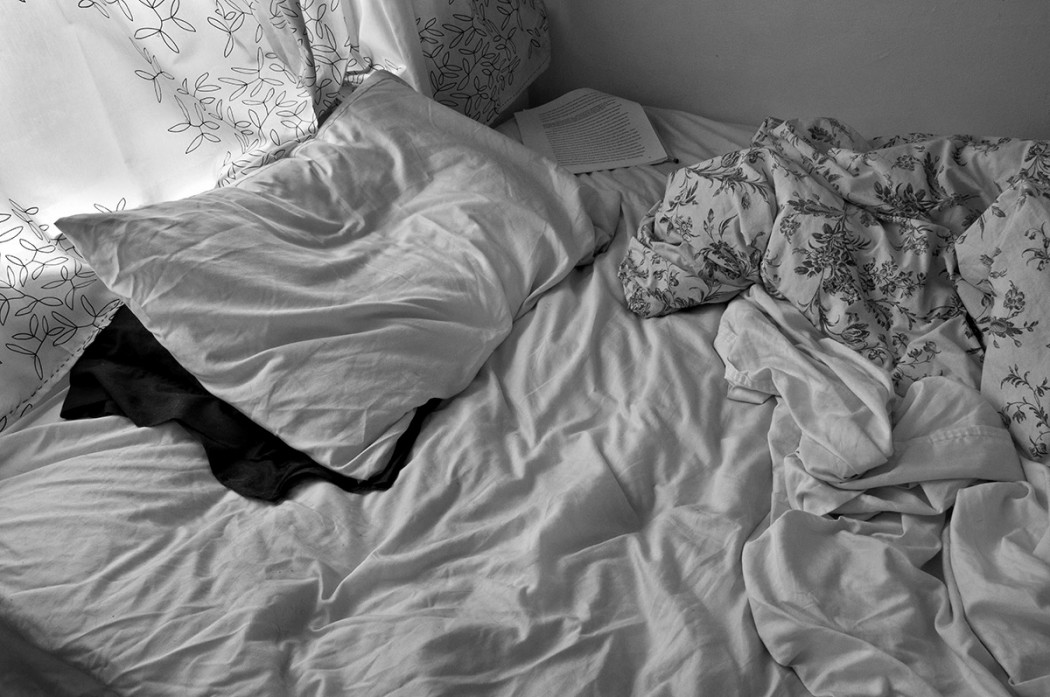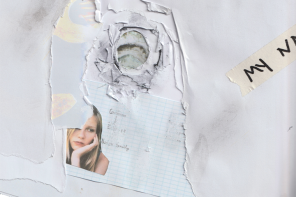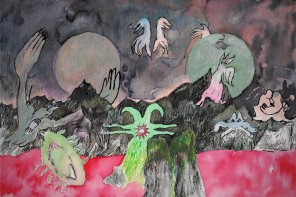During Coven’s Feminist Conqueerors exhibition, I co-hosted a discussion about queer femme experiences, and I’m not exaggerating in the slightest when I say that it changed my life. This has been a big year for me, in terms of evaluating and rethinking my engagement with others, particularly in a queer context (in my community, with partners, friends, and chosen family). Being in a room with a bunch of other queer people, mostly women, who identified somewhere along a femme spectrum (and a few others who came along to support), and discussing our feelings and frustrations opened up for me that the tension I felt between different parts of my identity and my expression of them are real and legitimate. While I have pretty consistently accepted my own femme identity in immediate terms, before this year I hadn’t considered that it might have an effect on the way others and indeed, I myself, engage with my queerness.
Like many queer people my age from the US, my first engagement with my sexuality happened in the context of the mainstream gay rights movement — with marriage equality front and center. Such environments tend to be dominated by gay men, casual misogyny, and unflattering ideas about lesbians, and thus were not spaces in which I felt comfortable or welcome in taking leadership or activist positions, although I desperately wanted that dialogue. My romantic relationships, however, did make me feel engaged on some level, and in this sense were my primary outlet for activism; a performance to prove an intended point, as well as relationships in which I was a partner. The ‘point’ initially was marriage in a relatively conservative sense, but that evolved. I found communities and friends that focused on intersectional queer issues, on liberation politics, on the kind of action and activism of which I’d only dreamt.
I also found, though, that my femme presentation became an issue in ways it hadn’t been prior. Spaces dominated by gay men didn’t tend to be queer only, so even if I was assumed to be straight, straight female friends weren’t uncommon. Queer spaces and especially queer women’s spaces are often exclusive, implicitly if not explicitly, and I still find myself having to argue for my ability to access safe spaces when I need them. I’m frequently assumed to be straight and lost, or the nearest butch person’s apolitical girlfriend, or ‘inexperienced’ and still dressing for men (which is both biphobic and a heteronormative view of femme presentation).
I struggled with heavy frustration in my engagement with radical queer spaces. I felt let down that spaces that otherwise espoused ideas that I was so entirely on board with could exclude queer femmes while upholding queer masculinity as unquestionably revolutionary. I did not understand how they couldn’t see how easily that plays into our society’s disrespect for anything primarily associated with women. I was frustrated that so many people felt comfortable automatically dismissing anything they associated with femininity as patriarchal, overlooking the value of queer women and others who turn these signifiers on their heads. This is particularly true of those for whom the ‘patriarchal’ ideal of femininity will never be possible (queer people, women of color, disabled people, non-binary people, and trans women, among others and in combination). I was and am frustrated that people assumed sexual submissiveness, inexperience, and an automatically gendered dynamic in a supposedly radical space.
We know that our societies socialize women to aspire to monogamous, heteronormative, two-person relationships with men. They also socialize women to feel primary responsibility
for the outcome of such relationships. Women are supposed to be wholly satisfied by their relationship, which eliminates their need for other interactions. This storyline is omnipresent in media and traditional expectations. This is the basic model for the nuclear family as one’s center of engagement versus one’s community at large. The same does not hold true for women who love other women, though. In literature, film, and various other types of media, the message we are given is that we will struggle for love, but not be in love. Our stories are spent realizing our sexualities, finding someone to kiss, then either suffering until we kiss them, or after we kiss them, or both. Our stories end in tears, in death, or if we’re lucky, the kiss itself. Yet, across media, we retain our socialization, sacrifice, and push for the traditional payout, against all the odds.
We don’t get to be happy, whatever that means to us. We are allowed to suffer in a way that appeases a heteronormative idea of queer suffering, or to insist that we are totally normal, just like straight people, only gay. Neither one, of course, allows queer people the expression of the full, rich, and varied lives that we live. But in the tropes, it’s been pretty clear: women are to aspire to a relationship and invest wholly in it, achieving happiness, yet women who love other women don’t get to be happy, no matter how we go about it. Queerness is inherently infused with pain. My own earliest relationships ended with my partners’ parents breaking it off, convinced that I’d ‘turned’ their daughters gay, while I watched friends experience worse from their own families. Most of the queer women I know have experienced violence, sexual and otherwise, since coming out, and most of us get harassed pretty frequently. Negotiating coming out over and over in different contexts at different points in our lives is a struggle, especially for femmes and others whose queerness is not automatically assumed in most spaces.
Not only are our bodies considered primarily for the gratification of straight men, but so are our relationships, especially for femmes with other femmes. Our intimacies, our pain, and our joys, reduced to a fetishized fantasy and the ever-present, “So, can I watch?” This is reproduced in supposedly LGBTQIA-friendly media, with its constant use of femme and femme-adjacent characters, leading some to say that femmes are more acceptable, while forgetting that sexualization is not representation — and how often we are invisible in our own communities. It is the bitterness at the end of each relationship, the sinking feeling because we knew that we weren’t meant to be in love, that love and happiness are things that don’t belong to us. If we know deep down that even straight women have to settle in this framework, how dare we expect to fall in love, to have our needs met, to be happy? We broke all the rules.
Somewhere between gendered expectations, isolation, and archetypes, I began to see romantic relationships as aspirations rather than explorations. A relationship in the most normative way was an idealized refuge from constant negotiations of my place within my communities, an end goal, a desirable outcome, rather than a journey involving another person. This year has been mostly devoted to unlearning that, to decoupling queer love from its inevitable outcome of pain by refusing to see it as an outcome but as an experience. To push for dialogue about our engagement with one another, both in communities and in relationships of all kinds, and to do away with the notion that a ‘strong’ relationship would do away with the necessity for my dialogue with others. To rethink what the concept of a relationship means to me, and what I’d like it to mean, monogamous, polyamorous, or otherwise. To understand that this definition can change over time, as my needs and boundaries shift. To consider how I engage with my friends and family outside of my relationships, and how to show them that they are important, in a society that very much condones the significance of romantic relationships and nuclear families above all others. Above all, how to be good to others and good to myself, in spite of it all.
Words and visual by Kiona H Niehaus








